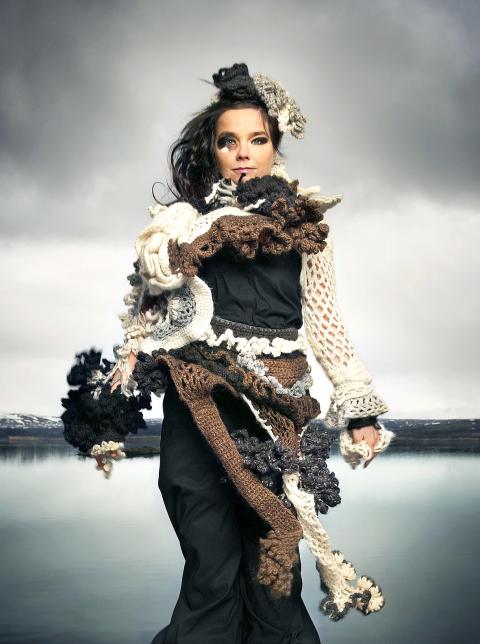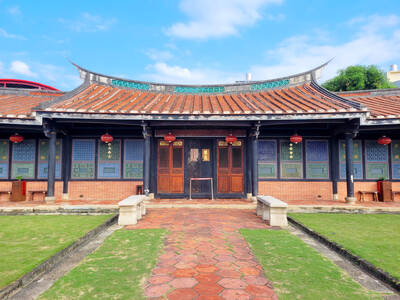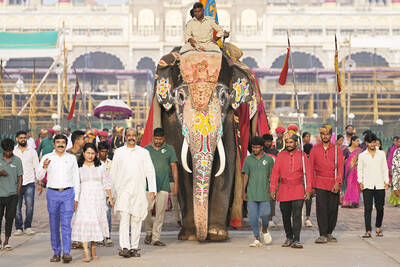Originally formulated by scientist Edward O. Wilson, the biophilia hypothesis suggests that human beings have an innate affinity with the natural world — plants, animals or even the weather. Yet it’s not biophilia but good old-fashioned fandom that has drawn a small band of Bjork obsessives to queue outside Manchester’s Campfield Market Hall since 10am. Not that there’s anything old-fashioned about the woman they are here to see. Biophilia is the Icelandic singer’s new project — the word means “love of living things” — and promises to push the envelope so far you’ll need the Hubble telescope to see it.
A collection of journalists has already had a preview at a press conference in the Museum of Science and Industry over the road. Bjork is absent, preparing for the live show, her first in the UK for over three years, which will open the Manchester international festival. Instead, artist and app developer Scott Snibbe, musicologist Nikki Dibben and project coordinator James Merry talk through Biophilia’s many layers. There will be an album in September, with an app to go with each of the 10 songs. There will be an education project, designed to teach children about nature, music and technology — some local kids will embark on it next week. There will be a documentary. And then there was a show scheduled for last night that was to be performed in the round to a 2,000-strong crowd including journalists representing publications from New Scientist to the New York Times, as well as the diehard fans waiting outside. One, 20-year-old Nick from London, is a classical violinist who has loved Bjork since the age of 14. “I wasn’t really into pop at all until I heard Medulla,” he says, citing her most challenging album. “It was like a gateway drug from me liking difficult 20th-century Western art music to liking pop.”
It’s a journey in the opposite direction from the one most music fans make, and one that speaks volumes about the complexity of Bjork’s work. “More classical musicians respect Bjork than any other pop star,” he adds.

Photo: Bloomberg
At the museum, Snibbe is demonstrating the apps. The app that goes with the first single, Crystalline, includes a game in which you collect crystals in a tunnel, through which process you alter and customize the music. The app also includes an abstract version of the musical score; and an essay by Dibben that explains, in this case, how the structures of crystals relate to the musical structure of the song. The app for another song, Cosmogony, presents a 3D cosmos you can navigate. Each app has been created by a different — often rival — developer. “To me, it feels like the birth of opera or the birth of cinema,” Snibbe says.
Yet Bjork didn’t have such lofty aspirations in creating the project. “My main aim is to not get too bored myself,” she says, via e-mail (she rests her voice between shows). “I feel that if I’m curious and excited there is a bigger chance the listener might be. At the end of the day, it’s more about the feeling of an adventure rather than the details of the adventure itself. So in short: whatever turns you on.”
That said, the change from a passive to an active listening experience is a radical one.
“The apps are mostly made for headphones and a private experience,” Bjork says. “What you see live is only us playing our version. You can play a totally different version at home.” If you’ve no desire to do that, Biophilia will still exist as a CD or download.
At the show venue, the journalists are being given a tour of the new instruments that have been specially built for the project. One contraption looks like a giant silver mangle decorated with two massive ear trumpets, but is called a sharpsichord. There are two giant pendulums that have strings plucked by a plectrum as they swing past. There’s a Tesla coil that descends in a cage from the ceiling; two prongs that emit purple flashes of lightning — and, with it, sound. There’s also a celeste that has been gutted and fitted with the pipes of a gamelan. These fantastical devices are controlled by an iPad. Above the performance space is a circle of screens that show the apps for each new song; moving tectonic plates for Mutual Core; invading pink cells for Virus (“Like a virus needs a body, as soft tissue feeds on blood, I will find you, the urge is here,” go the lyrics).
It must be one of the most complex pop shows ever, and according to Bjork, it could have been more elaborate still. “Manchester is the prototype,” she says. “We had to leave many things out because of budget and time and stuff.” As it is, the whole project has taken three years and cost so much money she told Rolling Stone that “we’ll be lucky if we earn zero.”
Yet, on purely artistic grounds, it’s hard to regard Biophilia as anything other than a success. As the lights go down, Bjork’s childhood hero David Attenborough’s unmistakable voice, recorded just that day, fills the room to explain the songs. The show includes Bjork’s favorite footage from BBC nature documentaries playing when she performs older songs. Hidden Place is illustrated by a beautiful but disturbing clip from Attenborough’s Life — of a seal’s corpse being devoured by psychedelically colored worms and starfish. All 10 tracks from the new album are played. Such an onslaught of new material would try the patience of most audiences, but this one is rapt — no one even goes to the bar.
Much of this is due to the sensory bombardment of music, images and costumes — not least Bjork’s bright orange wig, which a comment on the Guardian’s review says makes her resemble a tamarin monkey. Her decision to ban cameras from the venue has also played its part. “I feel since everyone has made such an effort to be there all together at the same place and time, we might as well go for it,” she says. “It can be hard to play music for people who are filming you for Twitter or whatever. It’s like going to a restaurant with someone who keeps texting their friends while you are speaking to them — hard to concentrate.”
Then there’s Bjork’s extraordinary voice, once compared by Bono to an icepick, and still imperishable at 45. “My voice has changed,” she says. “I thought it had gone a little deeper. On my last tour I got nodules [on the vocal cords] but managed to stretch it out with three years of vocal work, so I’m back to my old range now.” Bjork “adores” a whole range of singers: “Chaka Khan, Beyonce, Antony” — the latter being Antony Hegarty, a former collaborator who is here in the audience — though her “favorite singer alive today” is Azerbaijani devotional singer Alim Qasimov. She is accompanied by a 24-piece Icelandic choir she discovered on YouTube.
After spending so long meticulously making Biophilia, performance feels liberating. Live shows and making an album are, says Bjork, “extreme opposites. After noodling for ever on an album, gathering together the best moments, it’s refreshing and healthy to have to do it all in one whack. Then you sort of have to take real life into it and accept that you only have whatever you have that day — and that is enough.”
Right now Bjork is at the intersection of music, nature and technology, exploring how the three together might help build a more sustainable future. But is it still pop? “Yes, absolutely!” Bjork claims. “Or perhaps I would rather call it folk music — folk music of our time. I was never too much into Warhol and the whole pop thing — it felt a bit superficial. I prefer folk. People. Humans.”

Last week saw the appearance of another odious screed full of lies from the People’s Republic of China (PRC) Ambassador to Australia, Xiao Qian (肖千), in the Financial Review, a major Australian paper. Xiao’s piece was presented without challenge or caveat. His “Seven truths on why Taiwan always will be China’s” presented a “greatest hits” of the litany of PRC falsehoods. This includes: Taiwan’s indigenous peoples were descended from the people of China 30,000 years ago; a “Chinese” imperial government administrated Taiwan in the 14th century; Koxinga, also known as Cheng Cheng-kung (鄭成功), “recovered” Taiwan for China; the Qing owned

When 17-year-old Lin Shih (林石) crossed the Taiwan Strait in 1746 with a group of settlers, he could hardly have known the magnitude of wealth and influence his family would later amass on the island, or that one day tourists would be walking through the home of his descendants in central Taiwan. He might also have been surprised to see the family home located in Wufeng District (霧峰) of Taichung, as Lin initially settled further north in what is now Dali District (大里). However, after the Qing executed him for his alleged participation in the Lin Shuang-Wen Rebellion (林爽文事件), his grandsons were

I am kneeling quite awkwardly on a cushion in a yoga studio in London’s Shoreditch on an unseasonably chilly Wednesday and wondering when exactly will be the optimum time to rearrange my legs. I have an ice-cold mango and passion fruit kombucha beside me and an agonising case of pins and needles. The solution to pins and needles, I learned a few years ago, is to directly confront the agony: pull your legs out from underneath you, bend your toes up as high as they can reach, and yes, it will hurt far more initially, but then the pain subsides.

A jumbo operation is moving 20 elephants across the breadth of India to the mammoth private zoo set up by the son of Asia’s richest man, adjoining a sprawling oil refinery. The elephants have been “freed from the exploitative logging industry,” according to the Vantara Animal Rescue Centre, run by Anant Ambani, son of the billionaire head of Reliance Industries Mukesh Ambani, a close ally of Prime Minister Narendra Modi. The sheer scale of the self-declared “world’s biggest wild animal rescue center” has raised eyebrows — including more than 50 bears, 160 tigers, 200 lions, 250 leopards and 900 crocodiles, according to